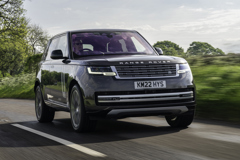Volkswagen Multivan Review 2025
Volkswagen Multivan At A Glance
Once the perennial standard bearer in the world of plushly finished, van-based MPVs, the Volkswagen Caravelle is no more, gone along with the VW Transporter van it was derived from. In its place, VW’s Commercial Vehicle division has used the underpinnings that form the basis of almost everything with an engine from the Golf upwards — read our full Volkswagen Multivan review to discover how good it is.
Providing unrivalled practicality and comfort for larger groups or those with stacks of luggage, the VW Caravelle bossed this corner of the market for decades making it a hard act to follow.
Its Volkswagen Multivan replacement is a true MPV, standing apart from humdrum seven-seat SUVs by dint of having individual, adult-sized seats, all of which can be slid back and forth or removed from the vehicle completely.
Despite its name and being developed by Volkswagen Commercial Vehicles, the VW Multivan is only sold as a car, with no panel van model spun-off from the design.
As the Multivan’s powered by combustion engines, we’re sticking with rivals that do the same including the aged and basic Renault Trafic Passenger plus the larger Ford Tourneo Custom. Ironically, a restyled version of the Ford went on sale in summer 2025 badged as the Volkswagen Transporter Shuttle.
Perhaps the most natural of the VW’s alternatives is the luxurious Mercedes V-Class, now two facelifts old in an attempt to hide its 11-year-old design. Not that age stops Mercedes charging heartily for the V-Class — the cheapest in the range costs more than the priciest £67k Multivan.
Two lengths of body are offered for the VW Multivan, both of which ride on the same wheelbase. As all of the rear seats slide back and forth on rails, whether you maximise room for passengers or luggage with either size car is entirely your choice.
Should you wish, for a small extra fee the central third-row seats can be deleted and replaced by a second set of captain’s chairs making it a six seater, while those in row 2 can then be spun 180 degrees making the back much more sociable.
Lob in a clever, sliding central console with fold out tables on each side, Hungry Hippo quantities of cupholders and enough USB ports for everyone to charge their gadgets and the Multivan becomes every jaded parent’s dream for keeping their brood comfortable and occupied.
Glitches? Well, though it’s a bonus that any of the five rear seats can be removed, that becomes more of a necessity because the seat backs don’t fold flat forwards, so if you wish to load large itsems inside the cabin, you’ll have to remove some to accommodate the cargo. Happily, the seats are far lighter than the Caravelle’s ever were, so hernia trusses should remain out of the equation.
There are a trio of engines currently available for the Volkswagen Multivan. Both the 150PS TDI diesel and 204PS TSI petrol are front-wheel drive, while the PHEV 245PS TSI eHybrid has 4Motion four-wheel drive thanks to an electric motor driving the back wheels while the 1.5-litre engine takes care of the fronts. It can also manage up to 57 miles of electric-only driving according to the WLTP Combined cycle.
Comfortable, cleverly arranged and just about looking like the MPV in its own right it really is, rather than one evolved from a van body, the Volkswagen Multivan serves as a reminder to seven-seater SUV buyers that there really is a better way to ferry children, adults and all their cargo around.
Reviews for Volkswagen Multivan's top 3 rivals
Volkswagen Multivan handling and engines
Volkswagen Multivan 2025: Handling and ride quality
Driving the eHybrid-badged PHEV version of the Volkswagen Multivan which proves to be no chore at all, despite its considerable size and weight, which is a minimum of 2391kg.
It’s a big old bus to pilot around town but the steering’s light and accurate, while all-round visibility’s better than you’d expect. The rear view suffers with a central passenger in the third row, but those big, van-size door mirrors gang up with parking sensors and a rear-view camera to keep you out of trouble.
Even empty of passengers, the suspension deals surprisingly well with lumps and bumps, any firmness or crashing abating increasingly the more people you welcome on board. The eHybrid can do 20-25 miles on electric power alone around town, stepping off the line pretty smartish for such a large beast.
Motorway manners are relaxed, the drive system settling into a quiet cruise once you’re up to speed. A little wind noise from the InterCity 125-aping front and those big door mirrors doesn’t spoil the overall feeling of comfort and refinement. At speed, the initial reaction to potholes and expansion joints is an audible thwack but the disturbance is more heard than felt.
This is not, however, a machine you want to be chucking down your favourite B-road. Sure, it’s a little less lumbersome than the Mercedes V-Class but it doesn’t like to be hustled down a country lane. It will lean a deal though corners and grip levels, though perfectly acceptable for this type of car, don’t lend themselves to heroics.
Adaptive suspension is available as an option, but even Sport mode doesn’t make overmuch difference to the Multivan’s propensity to lean through the bends. If you do choose to press on, the steering’s surprisingly satisfying for such a big machine and it’s the loss of front tyre grip that will be the primary cause of your undoing.
Volkswagen Multivan 2025: Engines
The Volkswagen Multivan is available with a choice of three engines at present, down one following the removal of the 1.5-litre TSI 136PS from the price lists.
Four-cylinder turbocharged petrol power takes the form of the 204PS 2.0-litre TSI engine which produces 320Nm of torque. The result is a 9.0-second 0-62mph time and a 124mph top speed, with drive sent to the front wheels via a seven-speed DSG dual-clutch automatic transmission.
That same transmission features in the 2.0-litre TDI with 150PS and 360Nm of torque at its disposal. It requires 11.6 seconds for the 0-62mph benchmark, while the top speed’s also lower at 118mph.
Pairing a smaller petrol engine up front with an electric at the back provides the 1.5-litre TSI eHybrid with 4Motion all-wheel drive, enabling it to make more effective use of its total outputs of 245PS and 350Nm. No 0-62mph time is presently quoted although its top speed is — 124mph. Still a DSG automatic, the eHybrid’s transmission has six rather than seven gears.
Volkswagen Multivan 2025: Safety
Large MPVs don’t come much safer than the Volkswagen Multivan. When tested by Euro NCAP in May 2022 it received the highest-possible five-star rating, scoring exceptionally well in three out of four categories, with a marginally weaker score of 69% for Vulnerable Road Users possibly due to the car’s bluff frontage.
Ratings of 90% and 89% for adult and child occupants respectively are highly impressive, with less common features including a centre airbag between driver and front passenger to stop them banging into each other in a crash. A score of 87% in the tricky Safety Assist category acknowledges the effectiveness of the standard autonomous emergency braking system and lane-keeping aids.
Other safety equipment that comes as standard is road sign recognition, adaptive cruise control and automatic post-collision braking, while Style models come with blind-spot monitoring and rear cross-traffic alert. All models come with more airbags than you can shake a stick at, which is reassuring if you’re going to fill the Multivan with children.
Which you can, because all the seats in the second and third rows come with Isofix and i-Size mounting points, including top tethers. That means space for up to five securely fitted child seats.
Volkswagen Multivan 2025: Towing
When fitted with the TSI and TDI engines, the Volkswagen Multivan has a braked trailer towing capacity of 2000kg, although that drops to 1600kg with the eHybrid versions.
Volkswagen Multivan interior
Volkswagen Multivan 2025: Practicality
There’s no escaping the fact that the Volkswagen Multivan is a big car. Even the standard-length version stretches just an inch short of five metres, while the long version adds another 200mm.
While most van-based MPVs have six seats combined in rows 2 and 3, with some even boasting a double front passenger seat raising the overall total to nine, that’s not the case with this VW. Its standard — and maximum — seating capacity is seven, with a six-seater package being an extra-cost option. This loss of carrying capacity is the Multivan’s main drawback against its rivals.
Adjustment to everything on the driver’s seat except lumbar support is manual, even in the pricier Style versions. Altering the seat back angle is a hot fidgety fuss because the armrest — even the driver’s seat has two — gets in the way of the knob. Once sorted, a comfortable driving position is marred only slightly by a steering wheel angled away from you rather too much, in traditional van fashion.
The absence of a double front passenger seat means access to the rear chairs rear from the front is easy, especially since the centre console — replete with two fold-out tables — will slide out of the way down the full length of the interior.
Thanks to flush tracks in the floor, all of the adult-size rear seats slide to let you apportion legroom as you choose making accessing the third-row seating even more of a doddle. Opt for the long-wheelbase version and the rear occupants will have room to really stretch out. The seats also recline and are equipped with practical fold-down tables.
Multivans can also be specified in an even more opulent six-seater layout for an additional £138. Here the middle row seats can turn around though 180 degrees for a conference-style layout, an option that can also be fitted to seven-seater versions for £426.
Sliding the centre console into a central position therein gives the use of two tables to four occupants. Another advantage of the track system is that it has an electrical connection, meaning that the outer rear seats in both rows can be optionally heated.
Though it’s a bonus that any of the five rear seats can be removed, that becomes more of a necessity because the seat backs don’t fold flat forwards, so if you wish to load skis inside the cabin, for instance, you’ll have to remove the central seat from the third row and you’re immediately back down to a six-seater.
Happily they’re are a great deal lighter than previous offerings, weighing 25-29kg depending on specification and position.
Both the sliding rear side doors and top-hinged tailgate are electrically operated in Style level cars.
Boot space for the standard-length VW Multivan is typical of an MPV with all seats in place — limited — but you do get a hard cover that doubles as a divider, so you can at least stack stuff using the car’s height.
Loaded to the roof behind the third-row seating, the standard Multivan can hold up to 461 litres of luggage. Remove the third row of seats and this figure rises to 1316 litres. With all the rear seats gone, the total luggage space climbs to 2425 litres. Plump for the long-bodied version and you get an extra 200 litres of loadspace in each configuration.
Storage spaces abound throughout the cabin. There’s a generous glovebox, multi-level door bins and a couple of small, covered cubbies high on the dashboard. A central cubby flips open to reveal a pair of cupholders and smartphone shelf — rigged for optional wireless charging on the higher Style trim level and fitted with a pair of USB-C ports on lesser Life variants.
That aforementioned clever centre console will, at the press of a button, rise and deploy two fold-out tables, plus it’s littered with cupholders and a big storage drawer. There are also cupholders and USB-C ports along the cabin walls in the back.
Volkswagen Multivan 2025: Quality and finish
The Volkswagen Multivan’s standard fit digital dials and infotainment touchscreen, as well as the steering wheel and gear selector are all from VW’s passenger car range, so all is appropriately high tech and well made — the stuff of luxury people mover rather than jumped-up van. As long as you don’t let your hands wander too far down the dash or doors, where the materials don’t exactly feel as if they justify the price tag.
As you’d expect from a van, though, the dashboard is made from harder plastics. At least it has a range of textures to lift it one step above the ubiquitous rhino hide efforts of the electrically powered Stellantis large MPVs. However, even that would be better than the fake wood inserts on the dash of the range-topping Style specification car.
The rear compartment is carpeted and the flush-fitting track for the sliding seats tidily installed. We do wonder how long it will be before the tracks fill with grot in the manner of a sliding patio door. Overall this is a pleasing interior that has been well built. The materials and finishes look tidy and durable, while nothing creaks, rattles or groans.
Volkswagen Multivan 2025: Infotainment
Every Volkswagen Multivan gets a 10.0-inch touchscreen infotainment system with wireless Android Auto and Apple CarPlay smartphone mirroring. Wireless phone charging remains an option, but there are six USB-C ports dotted throughout the cabin. The Style version’s package also features an upgraded infotainment system with Alexa voice recognition.
Trouble is all physical switchgear has gone. An additional module below the infotainment screen acts as a direct access button panel to various functions but even so the system isn’t much fun to rub along with when it comes to trying to adjust the non-illuminated row of touch-sensitive controls for air-con and volume after dark.
A digital driver’s instrument cluster is standard and on the posh Style version has a configurable display that can be tinkered with via steering wheel-mounted buttons.
Volkswagen Multivan value for money
Volkswagen Multivan 2025: Prices
The Volkswagen Multivan is priced from £49,613 in Life trim and standard length with the 2.0-litre 150PS TDI diesel engine. Topping the range is the longer-bodied Style with a 2.0-litre 204PS TSI petrol motor at £66,925.
That makes it pricier than many of those pesky seven-seater SUVs but significantly cheaper than the Mercedes V-Class which starts at £76,320. Less plush is the Ford Tourneo Custom, although it’s still larger than the Multivan, explaining why it’s priced upwards of £59,713.
Similarly dimensioned to the Ford is the Renault Trafic Passenger — an aged and now comparatively basic alternative to the VW which still requires a minimum of £49,505 to buy new.
Volkswagen Multivan 2025: Running Costs
The Volkswage Multivan eHybrid has the best fuel economy on paper but you’ll need to charge up the battery regularly to get remotely near its WLTP Combined cycle claim of 353mpg. With a discharged battery, expect about 30mpg around town and more than 35mpg on a long motorway haul from the eHybrid.
Elsewhere in the engine range, the 2.0-litre TDI diesel will manage closer to its official WLTP figure of up to 43.5mpg, while with the 2.0-litre TSI petrol you’ll be doing well to get close to its claimed best of 31.7mpg.
These figures are fairly comparable with what you’d squeeze out of a Ford Tourneo Custom or a Mercedes V-class.
The VW Multivan PHEV sits in the 14% category for BIK company car tax, which is entirely reasonable. All versions are subject to the additional Expensive Car Supplement — often called the premium car tax — for models costing over £40,000.
The VW warranty is standard fare — three years/100,000miles, three years for paint and 12 years’ body protection.
Volkswagen Multivan eHybrid: Range and charging
Fitted with a 19.7kWh useable capacity battery, the VW Multivan eHybrid has a WLTP Combined cycle EV driving range of up to 57 miles.
Recharging can only be done using an AC connection with a low maximum energy flow rate of 3.6kW. Using a domestic wallbox charger with a Type 2 connection, a flat-to-full recharge requires 5 hours 30 minutes.
Satisfaction Index
 What is your car like to live with?
What is your car like to live with?
We need your help with our latest Satisfaction Index, so that we can help others make a smarter car buying decision. What's it like to live with your car? Love it? Loath it? We want to know. Let us know about your car - it will only take a few minutes and you could be helping thousands of others.
Help us with the Honest John Satisfaction Index nowVolkswagen Multivan models and specs
There are just two trim levels in the Volkswagen Multivan line-up — Life and Style.
Standard features on Volkswagen Multivan Life models include:
- 16-inch Syrakus alloy wheels
- LED daytime-running, head and tail lights
- Automatic main beam
- Automatic wipers
- Dark-tinted privacy windows for the second and third rows
- Electrically adjustable, heated and folding door mirrors
- Separately opening tailgate window
- Front and rear parking sensors
- Reversing camera
- Keyless starting
- Front seats with electrically adjustable lumbar support
- Five Isofix-equipped, independently sliding and removeable rear seats
- Leather-wrapped multifunction steering wheel
- Dark Silver Brushed interior trim decor panels
- Digital Cockpit driver’s display screen
- Multimedia system with 10.0-inch touchscreen
- DAB radio
- Wireless Apple CarPlay connectivity
- Total of six USB-C sockets throughout the interior
- Manual air-conditioning
- Auto-dimming interior rear-view mirror
- Sliding centre console that transforms into a table
- Adaptive cruise control
Additional and replacement features when upgrading to the Volkswagen Multivan Style include:
- 17-inch Dundrod, diamond-turned alloy wheels
- Matrix LED IQ.Light headlights
- Electrically heated windscreen
- Sliding window sections within rear doors
- Keyless entry
- Electrically operated sliding rear doors and tailgate
- Chrome bodywork trim and stainless steel tailgate finisher
- Two-tone ArtVelours seat upholstery with faux leather side bolsters
- Heated front seats
- Three-zone climate control
- Multicoloured interior ambient lighting
- Dark Woodgrain Optic interior decor trims


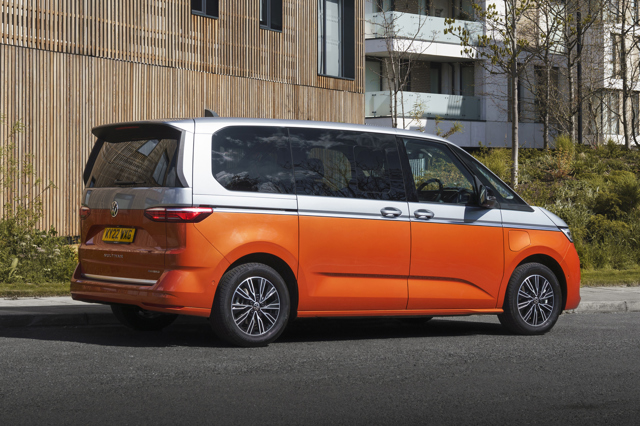
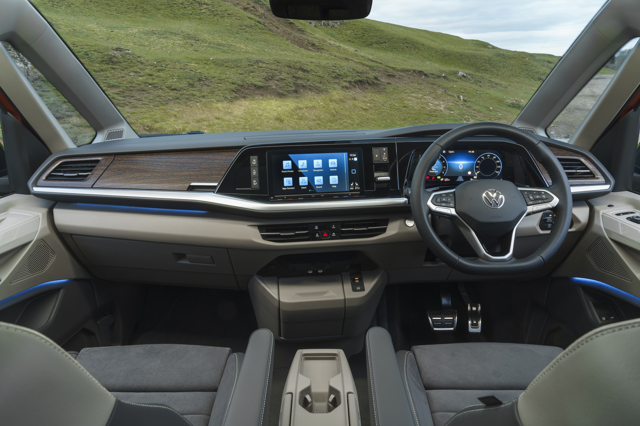

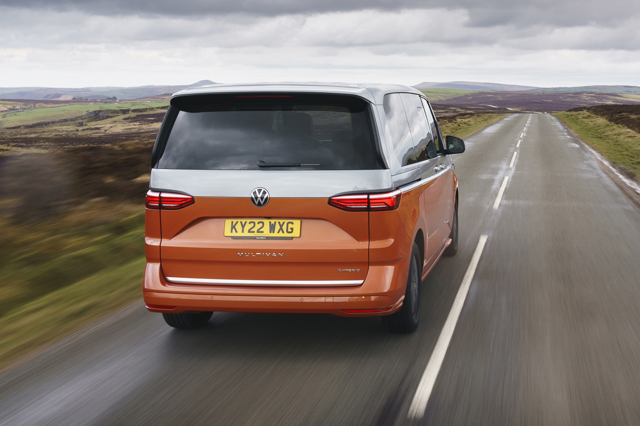
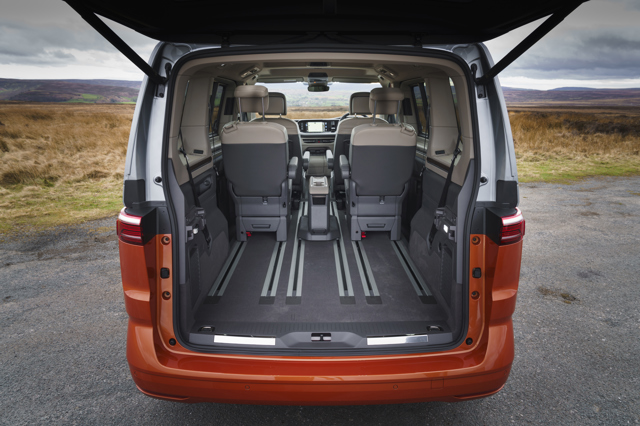


 Practical, spacious interior. Good to drive. Engine line-up includes PHEV.
Practical, spacious interior. Good to drive. Engine line-up includes PHEV.
 Maximum of seven seats. Infotainment system has annoyances. Ride quality less good with fewer passengers aboard.
Maximum of seven seats. Infotainment system has annoyances. Ride quality less good with fewer passengers aboard.


